Contents
Buzulnik palmatoloba (lat. Ligularia x palmatiloba) is a perennial from the Astrov family, also called hand-shaped. This plant is flowering, used in landscape design. It is planted in open ground with seeds or seedlings. Care must be comprehensive.
Description of the species
Buzulnik digitatoloba is one of the largest representatives of its kind. In height, the bush can reach 1,8 m and in diameter 0,9-1 m. The main characteristics of the perennial:
- powerful bush;
- peduncles up to 1,5-1,8 m;
- large lower leaf plates, having a rounded shape and deep lobes;
- loose inflorescences-baskets of a vertical racemose type;
- flowers are yellow;
- flowering is abundant, falls on July-August and lasts 25-30 days;
- the fruit is an achene with a tuft;
- winter hardiness zone 4, the plant survives frosts well down to -30-34 ° C.
Buzulnik palmate-lobed is able to grow in one place up to 20 years. It is recommended to divide and replant the bush every 5 years.
Application in landscape design
Buzulnik palmate-lobed is used in single and group plantings. It can be planted along fences, walls of houses and other buildings. The plant serves as an excellent background, masking the imperfections of vertical surfaces.
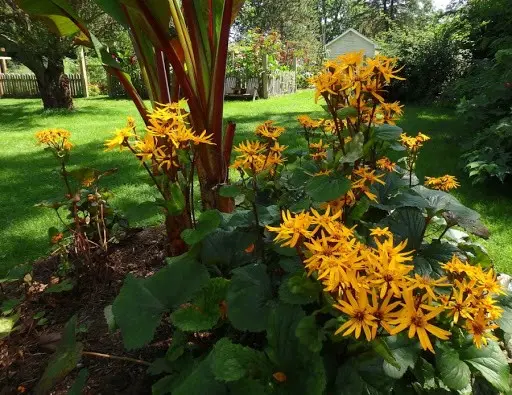
Buzulnik is planted under trees, filling empty spaces with it
The plant feels good near water bodies. On the shore it can be planted with other perennials:
- astilbe;
- swamp spurge;
- tall marsh irises;
- snake mountaineer;
- loosestrife;
- palm-leaved (muskingumen) sedge.
The palmate-lobed buzulnik is tall, therefore it is planted in flowerbeds in the center or in the background. The plant is well suited for mixborders – in this case, it is effective to plant a soft cuff in the foreground, the height of which does not exceed 0,5 m.
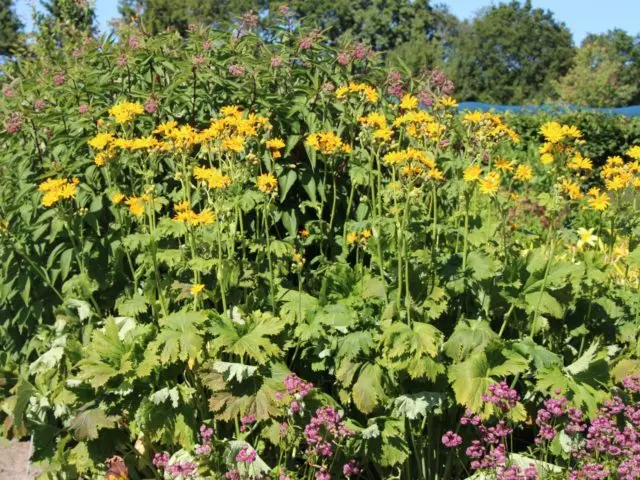
Buzulnik digitatoloba and other representatives of this species look good in single plantings on the lawn, creating accents on it
Features of reproduction
Buzulnik palmatoloba is a perennial, because it can be propagated not only by seeds, but also by dividing the bush. Both methods are simple.
You can collect the seeds yourself. To do this, select the inflorescences and tie them with gauze. It is necessary to remove the material after drying. It remains to dry the seeds on paper and put them in bags from it.
You can divide the bush at any time during the spring-autumn period. It is better to plan such an event for the spring, when the plant is actively developing. You can dig out the bush not entirely, but only part of it, separating it with a shovel.
The next algorithm is:
- Rinse the separated part of the bush in water.
- Divide it into parts so that each has a growth bud. Use a sharp knife for this, treat the slices with charcoal or potassium permanganate.
- Plant cuttings on a pre-prepared site, the earth must be dug up and fertilized. The kidneys are up to 3-5 cm above the surface.
Planting and care
For the successful cultivation of the palmate-lobed buzulnik, it is important to choose the right place, plant it at a certain time and provide proper care. We need an integrated approach.
Recommended dates
Pick-up time depends on the selected method and region. If the plant is planted with seeds in open ground, then work is carried out when the threat of frost has passed. Usually this is the end of spring.
Buzulnik can be planted with seedlings. They start growing it in March.
Self-collected seeds can be planted in late autumn, when the cold sets in. If this is done on warm days, the material will germinate and die.
Site selection and soil preparation
Buzulnik palchatolopatny is a shade-loving plant. It is good to plant it under trees, in places shaded by various buildings, a fence. The plant feels great near water bodies, because it is moisture-loving.
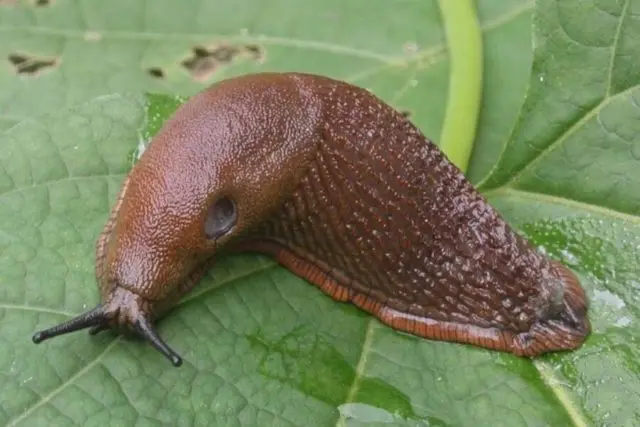
If the bush grows in a sunny place, then it is important to water it regularly.
The right soil is important for the successful cultivation of the palmate-bladed buzulnik:
- high humus content;
- good hydration;
- acidity level 5,6-7,8 pH;
- light soil, loam is recommended.
The plant is unpretentious, therefore it will take root well even on heavy clay soil. Poor soil should be fertilized before planting. You can fill the planting pits with fertile soil.
Landing algorithm
If you plan to plant seeds, then first they must be kept for half an hour in a solution of potassium permanganate. Stratification can be carried out in the spring. In autumn, such a measure is not needed.
When planting seeds in spring, proceed as follows:
- Dig up and level the area.
- Spill the earth, wait for the absorption of moisture.
- Make grooves or holes to a depth of 1 cm.
- Distribute the seeds, sprinkle with earth.
- Moisten the area regularly until seedlings appear. The earth must not dry out.
- Provide plantings with shading during daylight hours.
In autumn, seeds are planted according to the same algorithm. In the cold period, they undergo a natural stratification. For the winter, crops must be covered so that they do not freeze out.
If you plan to plant buzulnik seedlings, the algorithm is as follows:
- In January, wrap the seeds in a damp cloth, place in a bag and refrigerate.
- In March, prepare a container for seedlings and soil, you can use a ready-made mixture or take soil from the garden.
- Sow seeds in moist soil.
- Organize a transparent shelter. Remove after germination.
Buzulnik seedlings are better not to dive, but simply thin out. Care consists in regular moisturizing and top dressing 1 time in 2 weeks.
Watering and fertilizing schedule
Buzulnik palchatolopastny is a moisture-loving plant, therefore it needs regular watering. It must be moderate. During the dry season, the plant should be watered abundantly.
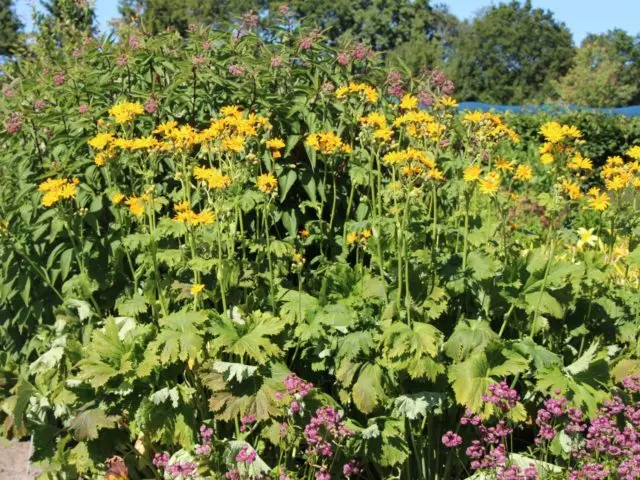
If the bushes grow in a windy place, then tying may be necessary.
Buzulnik is usually fed twice – in early spring and autumn. At the beginning of the season, the plant needs nitrogen fertilizers. They are introduced by spreading.
Buzulnik digitalis-lobed responds well to chelated fertilizers for ornamental and deciduous plants. They are brought in in a non-root way.
In autumn, it is recommended to add half a bucket of humus under a bush. Fertilizer should not fall on the roots.
Loosening and mulching
For good aeration, the soil must be loosened regularly. This should be done after watering and rains. At the same time, large weeds can be removed.
In order to have fewer weeds, and a crust does not appear on the soil, mulching is necessary. They make it with peat, straw, sawdust, needles, tree bark.
Trimming
It is not necessary to cut the palmate-lobed buzulnik. It is necessary to get rid of wilted inflorescences so that they do not spoil the beauty of the leaves of the plant.
Preparation for winter
Buzulnik palchatolopatny before winter should be cut off at the root. Do this when the first frosts come.
Buzulnik survives frosts well, but it is still worth mulching it for the winter. It is good to use needles, tree bark for this. Such a measure will help the plant not only in extreme cold, but also with insufficient snow cover.
Diseases and pests
Buzulnik is not very susceptible to diseases and is rarely affected by pests. One of its possible problems is powdery mildew. The disease is fungal, expressed as a white coating on the leaves. To combat it, fungicides are used – Fitosporin, Topaz. Effective copper sulfate.
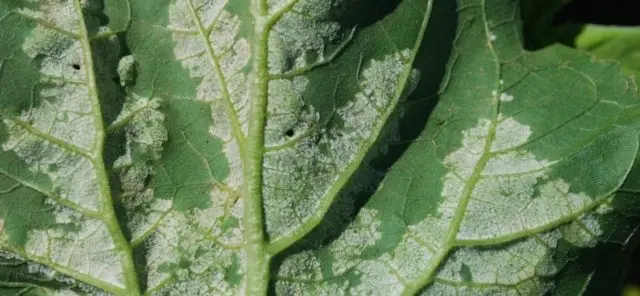
To prevent powdery mildew, it is necessary to burn plant residues, cut diseased shoots
Of the pests, the buzulnik often suffers from slugs. They can be collected by hand – do it early in the morning or after rain. The poison for slugs is metaldehyde. We need a drug in granules with a concentration of 5%. It is enough to scatter it on the ground.
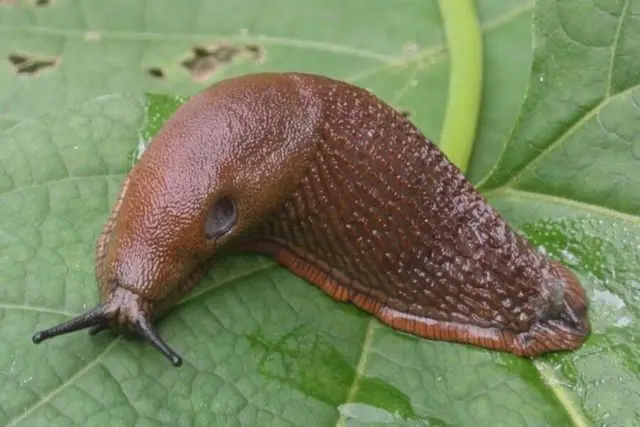
To prevent slugs, you need to regularly get rid of weeds and burn plant debris.
Conclusion
Buzulnik palchatolopastny is an unpretentious perennial that can be used in single and group plantings. It is easy to plant with seeds or seedlings, propagate by dividing the bush. Care should be comprehensive, regular watering is required.









